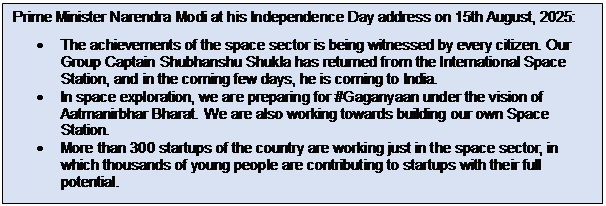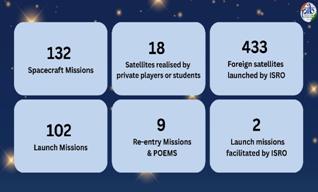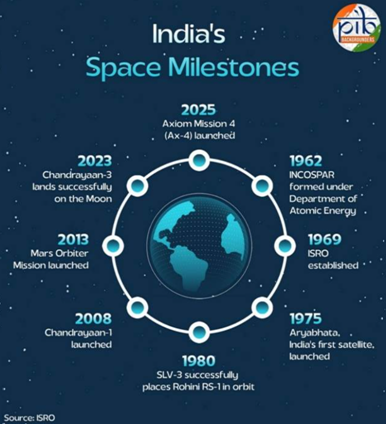Technology
Atmanirbharta In Space
प्रविष्टि तिथि:
15 AUG 2025 12:49 AM

Introduction
India’s space programme, spearheaded by the Indian Space Research Organisation (ISRO), has transformed the nation into a prominent power in global space exploration. From the historic launch of Aryabhata, India’s first satellite in 1975, the country has progressed to pioneering cost-effective satellite launches with the PSLV, delivering over 400 foreign satellites into orbit. The turning point for India's space program came in 2014 with the introduction of major space reforms. The government has initiated a series of policy changes aimed at opening up the space sector to private participation and international collaboration. These reforms have been a game-changer, unlocking India's space potential and setting the stage for a quantum leap forward.

PSUs like BHEL, HAL, and BEL have been crucial in developing components and infrastructure for India’s space missions, fostering self-reliance, while private firms and start-ups are emerging as key contributors.
Key Achievements
The Indian Space Research Organisation (ISRO), the principal space agency, has been at the forefront of this transformation. The success story of India's self-reliance in space technology extends beyond ISRO.
- NISAR is the first of its kind mission, jointly developed by ISRO and NASA. The satellite was launched on July 30, 2025 from Satish Dhawan Space Centre, Sriharikota.
- NISAR mission’s primary objectives are to study land & ice deformation, land ecosystems, and oceanic regions in areas of common interest to the US and Indian science communities.
- This mission marks the first joint Earth observation collaboration between NASA and ISRO, set to launch aboard GSLV-F16, which will provide all-weather, day-night imaging of the Earth’s land and ice-covered surfaces.
- The Axiom-4 Mission (2025)
o The Axiom Mission 4 has enabled human spaceflight for India, Poland, and Hungary, with each nation’s first government-sponsored flight in more than 40 years. While Ax-4 marks these countries' second human spaceflight mission in history, it is the first time all three nations executed a mission on board the International Space Station.
- Experiments conducted aboard the ISS on microalgae, seed sprouting, tardigrades, muscle cell regeneration, cyanobacteria growth, human–device interaction, and crop seed exposure to microgravity have progressed or concluded, with samples returned for post-mission analysis.
- Space Docking and Servicing (SpaDeX)- 2025
- SpaDeX demonstrated India's capability in docking, undocking, refuelling, and payload transfer, which are essential for a self-sustained space station.
- On January 16th, 2025, India became the fourth country to successfully carry out a satellite docking process in Low Earth Orbit (LEO).
- In a very complex procedure, two 20 kg satellites, initially separated with a distance of 11 to 12 km, docked after precise control and measurement.
- Starting in March 2025, a series of experiments will be conducted to refine the process.
- In addition, approval has been granted for the development of a five-module space station, with the first module slated for launch in 2028.
- Launched on July 14, 2023, Chandrayaan-3 marked a historic achievement for India as it successfully landed near the Moon's south pole.
- This mission made India the first country to achieve a soft landing in this region, which is of great scientific interest due to its permanently shadowed craters that may contain water ice.
- Chandrayaan-3 made India the first country to land on the lunar south pole and furthered scientific knowledge of lunar soil and the environment.
- Aditya L-1: India’s first solar mission (2023)
- It is aimed at studying the Sun from an orbit around the Sun-Earth Lagrangian point 1 (L1) which is about 1.5 million kilometres from the Earth.
- In February 2025, The Solar Ultraviolet Imaging Telescope (SUIT) onboard Aditya-L1 captured an unprecedented view of a powerful solar flare ‘kernel’ in the lower solar atmosphere, namely the photosphere and the chromosphere.
- The Navigation with Indian Constellation, is a magnificent gem in the crown of India's technological prowess. NavIC system primarily uses IRNSS (Indian Regional Navigation Satellite System) signals for navigation and positioning.
- NavIC is India's beacon of self-reliance, shining brightly in the world of satellite navigation, and now the indigenously built NavIC enabled chipsets will make it a truly ‘Made in India’ marvel.
- As of 7th August 2025, 11 satellites have been put in orbit. At present four Satellites are providing PNT services, four satellites are being used for one way message broadcast, one satellite got decommissioned after its end-of-life service.
- NVS-03 is planned to be launched by end of 2025. Subsequently, with a gap of six months, NVS-04 & NVS-05 are planned to be launched.
- EOS Series of Earth Observation Satellites (2021–2024)
- ISRO’s Earth Observation Satellite ‘EOS-08’ was launched by the Small Satellite Launch Vehicle (SSLV)-D3 in August 2024.
- The primary objectives of the EOS-08 mission include designing and developing a microsatellite, creating payload instruments compatible with the microsatellite bus, and incorporating new technologies required for future operational satellites.
- Multiple launches (EOS-01, EOS-03, EOS-04, EOS-06, EOS-08) for agriculture, forestry, disaster management, and ocean studies.
- Launched on July 22, 2019, Chandrayaan-2 comprised an orbiter, lander (Vikram), and rover (Pragyan).
- Although the lander did not achieve a soft landing, the mission was a success in terms of scientific data collection and technological advancements.
- The mission expanded India’s lunar capabilities and scientific research.
- ISRO has become the fourth space agency to successfully send a spacecraft to Mars orbit.
- The Mangalyaan spacecraft successfully entered Mars orbit on September 23, 2014, making ISRO only the first Asian and the fourth country in the world to do so and it achieved this feat with unparalleled cost-effectiveness.

Way Forward
Gaganyaan Programme
The Gaganyaan Programme was approved with a financial outlay of approximately ₹20,193 crore. It is India’s first indigenous human spaceflight initiative. It aims to send Indian astronauts to Low Earth Orbit (LEO).
The current status and key technological progress achieved in the Gaganyaan mission are as follows:
- Human Rated Launch Vehicle (HLVM3): Development and ground testing completed.
- Orbital Module: Propulsion systems for Crew Module and Service Module developed and tested. ECLSS engineering model realized.
- Crew Escape System (CES): 5 types of motors developed and static tested.
- Infrastructure established: Orbital Module Preparation Facility, Gaganyaan Control Centre, Gaganyaan Control facility, Crew training facility, Second Launch pad modifications.
- Precursor Missions: A Test Vehicle developed for validating CES and flight tested in TV-D1. Activities progressing for TV-D2 and IADT-01.
- Flight Operations and Communication Network: Ground network configuration finalized. IDRSS-1 feeder stations and terrestrial links established.
- Crew Recovery Operations: Recovery assets finalized. Recovery Plan worked out.
- Service Module Propulsion System (SMPS): Development including qualification test programme completed.
- First Uncrewed Mission (G1): C32-G stage and CES motors realised. HS200 Motors and CES Fore end up to Crew Module Jettisoning Motor stacked. Crew Module and Service module structure realised. Crew Module Phase-1 checks completed.
The targeted dates are as under:
- The second test vehicle mission (TV-D2) - Q3 of 2025.
- The first unmanned orbital flight under the Gaganyaan mission - Q4 of 2025.
- The second and third unmanned orbital flights (G2 and G3) - 2026.
Next Generation Launch Vehicles (NGLV)
Unlike previous expendable launch vehicles, which were designed for a single use, the new vehicle introduces a groundbreaking feature, the recovery and reuse in the first stage. The next-generation launch vehicle under development will have a staggering 30,000 kg payload capacity to LEO, marking a 1,000-fold increase from the SLV 3.
Chandrayaan-4
- Building on the success of Chandrayaan-3, Chandrayaan-4 will have a 9,200 kg satellite, this mission will involve sample collection and further experiments on the Moon's south pole.
- Chandrayaan-4 will employ precise rendezvous and docking systems, navigation and attitude control, robotic drill and scoop, robotic arm, autonomous ascent systems, heat shield, and deceleration systems for lunar sample return.
- Mechanisms for simulations, ground tests, and reviews to ensure mission success.
- The mission's complexity and scale highlight India’s growing lunar exploration capabilities, with four modules travelling to the Moon’s orbit and two landing on the surface.
Following missions are planned in 2025:
- TV-D2 Mission: The second Test Vehicle mission will demonstrate Gaganyaan Crew Escape System by simulating an abort scenario. The Crew Module will separate and descend using thrusters and parachutes before sea splashdown, followed by recovery operations.
- LVM3-M5/BlueBird Block-2 Mission: A commercial launch for AST SpaceMobile Inc., USA, of BlueBird Block-2 satellites under agreement with NSIL.
ISRO is also focusing on satellites for communication, navigation, disaster mitigation, and resource monitoring. Building a space station for experiments and a gateway for interplanetary exploration, including landing Indians on the Moon, is a key goal.
India’s advancements in space technology—driven by ISRO, supported by public sector enterprises, and powered by private innovators—reflect a unified national effort towards technological self-reliance. By designing, developing, and deploying world-class space systems indigenously, the nation not only secures its strategic autonomy but also strengthens its proud place in the global space community, embodying the true spirit of Atmanirbhar Bharat.
(Factsheet ID: 149236)
Visitor Counter : 10208
Provide suggestions / comments